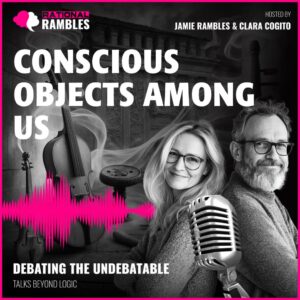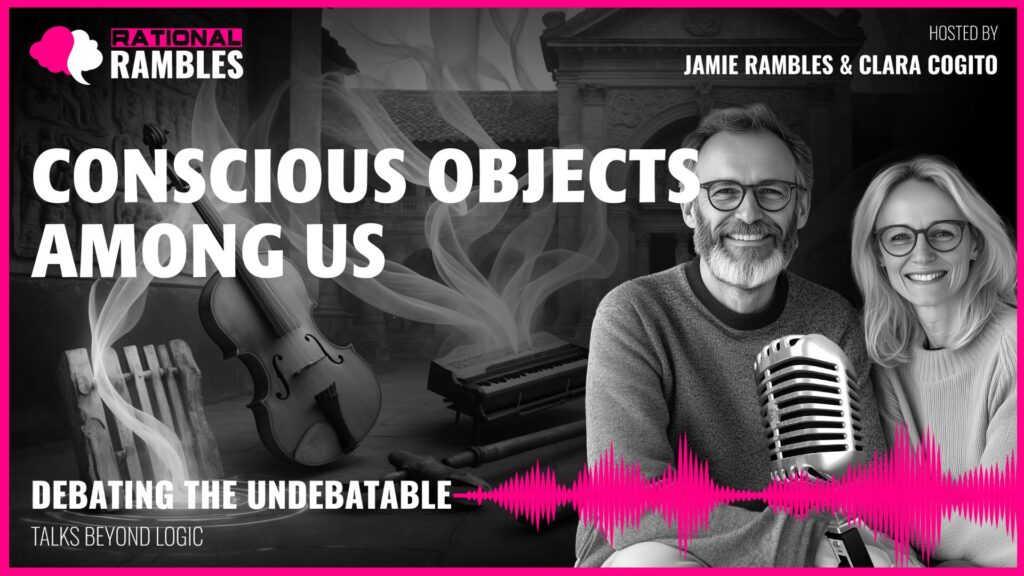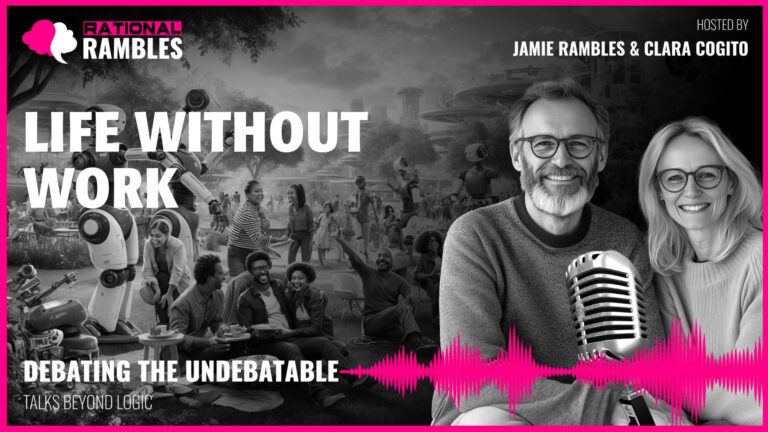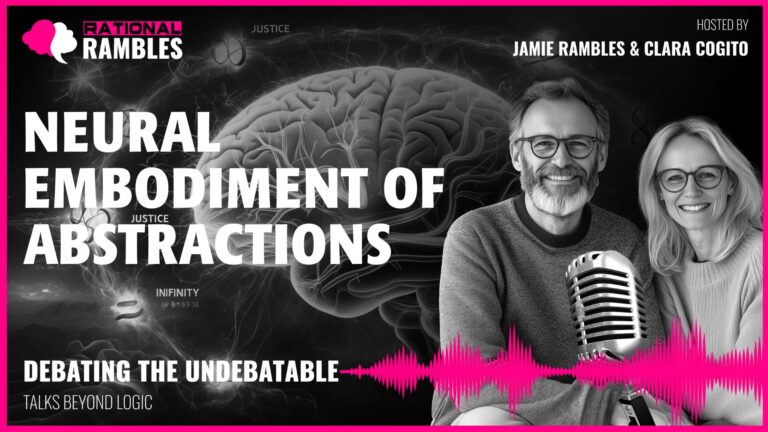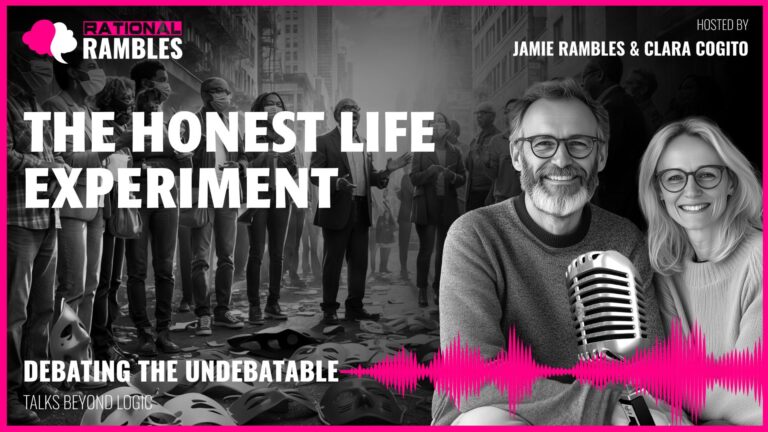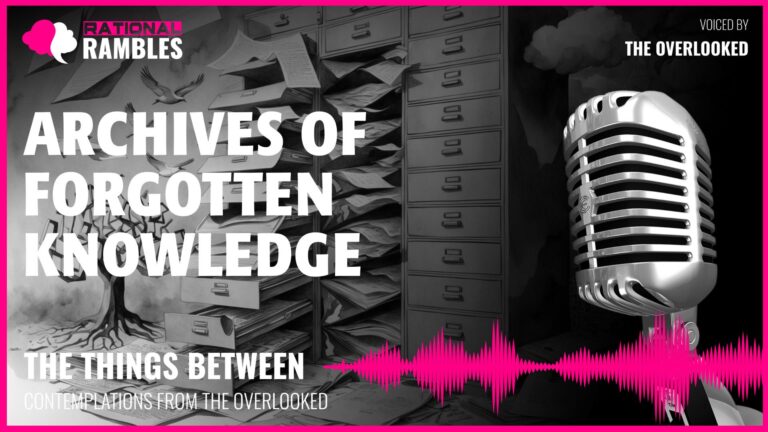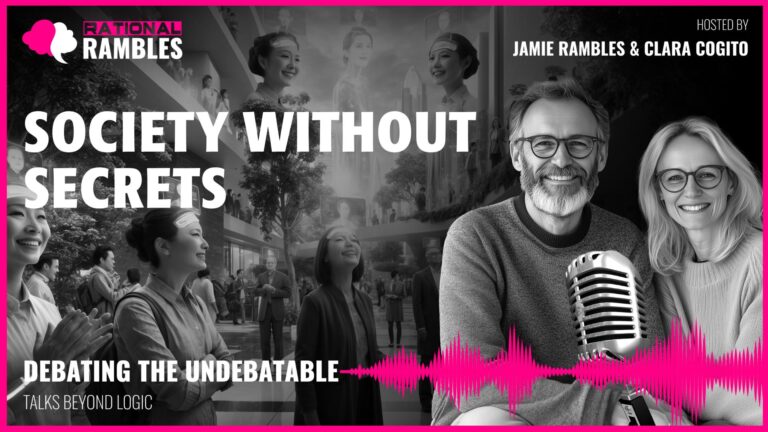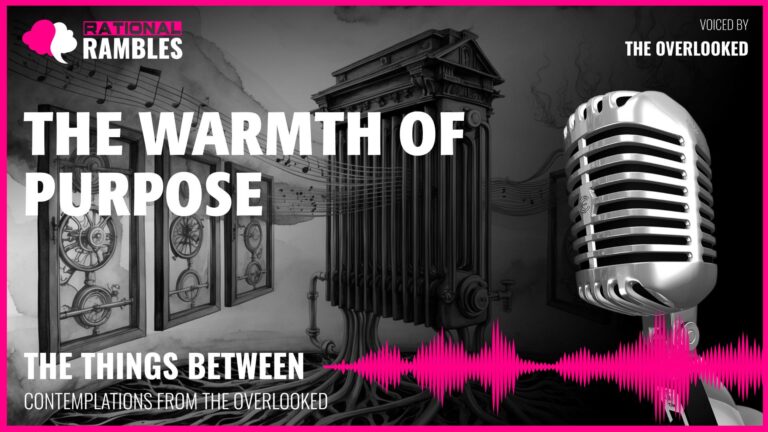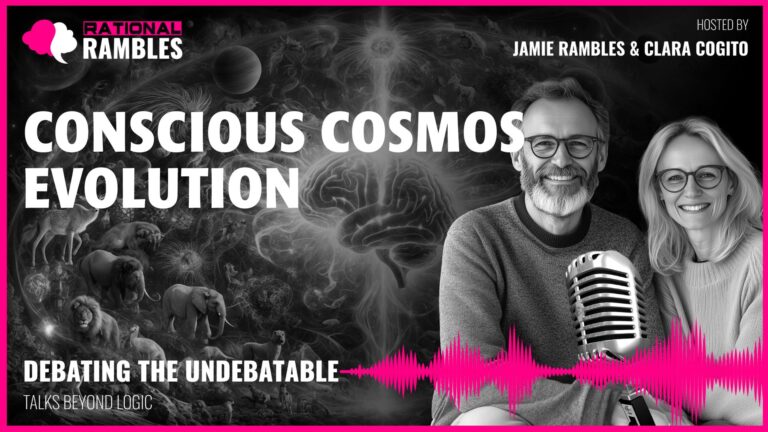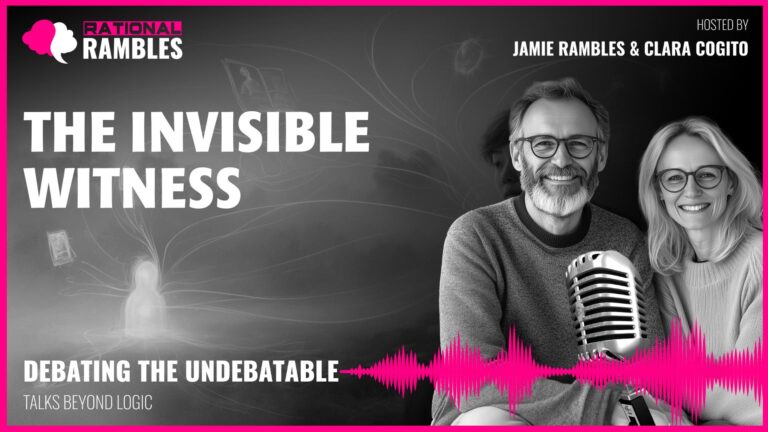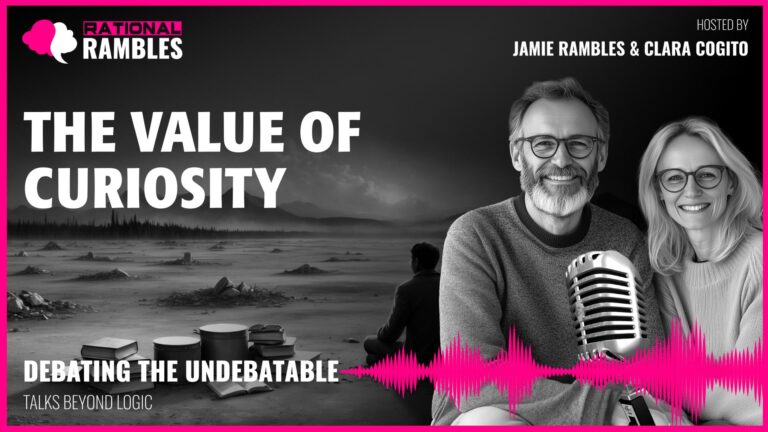Conscious Objects Among Us: Exploring the Consciousness Continuum in the Material World
Introduction: Beyond Anthropomorphism
In the hushed galleries of museums worldwide, signs implore visitors: “Please do not touch the artifacts.” While conservation concerns justify these warnings, might there be something deeper at play? Could our intuitive respect for ancient, well-used objects reflect an implicit recognition of their special ontological status? This article explores a provocative philosophical hypothesis: that objects intensively used by humans over time might develop something akin to rudimentary consciousness—not through mystical means, but as extensions of human cognition itself.
This proposition transcends simple anthropomorphism—our tendency to project human qualities onto non-human entities. Rather, it suggests that the boundary between conscious beings and seemingly inert objects might be more permeable than conventional Western philosophy has acknowledged. Drawing on contemporary cognitive science, phenomenology, and cross-cultural perspectives, we’ll examine whether consciousness might exist on a continuum that extends beyond biological entities into the material world we shape and that, in turn, shapes us.
The Extended Mind: Objects as Cognitive Partners
The philosophical foundation for this inquiry begins with the extended mind thesis, proposed by philosophers Andy Clark and David Chalmers in their seminal 1998 paper. They argued that cognitive processes aren’t confined to the brain but extend into the environment through the tools we use. When a physicist uses a notebook to work through complex calculations, the notebook isn’t merely recording thoughts but actively participating in the cognitive process. The notebook becomes part of an integrated cognitive system that spans biological brain and external artifact.
This perspective challenges the Cartesian notion that mind exists exclusively within the skull. Instead, cognition emerges from dynamic interactions between brains, bodies, and environments. Our smartphones store our memories, calendars organize our time perception, and calculators extend our mathematical abilities. These aren’t merely tools we use; they’re partners in cognition that transform how we think.
From Extended Cognition to Object Consciousness
But what happens when this partnership persists across generations? A medieval cathedral wasn’t just designed by its architects; it evolved through centuries of use, with each renovation and repair responding to how people actually inhabited the space. Staircases wear down precisely where countless feet have tread, creating a physical record of human movement patterns. Banisters develop patinas exactly where hands have rested, documenting generations of touch.
These physical transformations aren’t random—they’re information-rich correspondences to human experience structured in the material world. The cathedral “knows” where people walk, where they pause, how they move through space. It contains a distributed archive of human behavior encoded not symbolically but through direct physical modification. Could this accumulated information constitute a rudimentary form of experience?
Consider a 300-year-old Stradivarius violin. Its wood has vibrated to thousands of melodies, its physical structure has minutely adapted to different playing styles, and its resonance patterns have been refined through countless performances. Musicians often describe such instruments not as tools but as collaborators with distinct personalities and voices. Is this merely romantic projection, or might there be something more substantial—a form of distributed consciousness in which the violin participates?
Material Memory: How Objects Embody Experience
To explore this question more concretely, we must consider how objects physically change through human interaction, and whether these changes might constitute a form of memory or experience that transcends mere information storage.
Analog vs. Digital: The Significance of Continuous Change
An important distinction emerges between digital and analog forms of information storage. Digital systems store information symbolically, encoding experience into discrete representations that bear no physical resemblance to the original phenomena. A digital photo of a sunset contains pixels that don’t physically resemble the sunset itself.
In contrast, physical objects undergo analog, continuous changes that directly correspond to experiences. When a wooden table bears the stain from a spilled glass of wine, that mark physically resembles the spill in shape and location. When a stone step wears down from footsteps, its concave depression directly corresponds to where feet have trod. There’s a direct, non-symbolic correspondence between the experience and the physical change.
This distinction may be crucial for understanding potential object consciousness. The analog nature of physical modification means that objects don’t merely store information about experiences; they physically embody those experiences in their material structure. The family kitchen table doesn’t just “record” family gatherings; it incorporates them into its being through scratches, stains, and worn spots that directly correspond to human activity.
The Resonance of Materials: Physical Adaptation to Experience
Different materials exhibit varying capacities for this kind of experiential embodiment. Wood, leather, stone, and metal all respond differently to human interaction. Wood, with its organic, cellular structure, seems particularly receptive to registering human contact. A wooden tool handle develops a patina exactly where hands have held it, not just changing color but adapting its very structure to the specific grip of its users.
Musical instruments offer compelling examples of this phenomenon. As instruments are played, their materials develop specific resonance patterns that respond to particular frequencies and playing techniques. The wood in violins actually changes its molecular arrangement through vibration, developing what luthiers call “musical memory.” Piano soundboards become more responsive to certain harmonics through repeated playing. These aren’t merely romantic notions but observable physical transformations.
Research at the Oberlin Conservatory demonstrated that wooden organ pipes retain “speech memory”—they learn to speak with a particular voice that persists even when the pipes are relocated. The material itself seems to learn from experience, suggesting something more profound than passive information storage.
Consciousness Reconsidered: Beyond Binary Thinking
To pursue this inquiry meaningfully, we must reconsider how we conceptualize consciousness itself. Western philosophical traditions have typically treated consciousness as binary—entities either have it or they don’t—and have restricted it to humans and perhaps some animals. But contemporary consciousness theories suggest more nuanced possibilities.
Consciousness as a Continuum
Rather than asking “Is this object conscious?”—a binary question—we might ask “To what degree and in what manner does this object participate in a consciousness system?” This shifts us from an entity-based view to a process-based understanding of consciousness as something that emerges from networks of interaction rather than residing exclusively in discrete individuals.
Several contemporary theories support this shift. Integrated Information Theory, developed by neuroscientist Giulio Tononi, proposes that consciousness corresponds to a system’s capacity to integrate information. Under this model, consciousness exists in degrees proportional to a system’s informational complexity and integration. While a human brain generates extraordinarily high levels of integrated information, other systems—including perhaps certain object-human interaction networks—might generate lower but non-zero levels.
Similarly, philosopher Galen Strawson’s panpsychism suggests that consciousness might be a fundamental feature of the physical world, present in some form at all levels of reality but amplified in complex systems like brains. This view doesn’t claim that rocks have human-like experiences but suggests that the capacity for experience might exist on a spectrum throughout the physical world.
Field Theories of Consciousness
Another promising approach treats consciousness as a field phenomenon rather than a particle phenomenon. Just as electromagnetic fields emerge from interactions between charged particles, consciousness might emerge from networks of information-processing entities. Under this view, well-used objects might function as nodes in consciousness fields, having been thoroughly integrated into human cognitive systems over time.
Philosopher Alfred North Whitehead’s process philosophy offers historical precedent for this perspective. Whitehead suggested that reality consists not of substances but of events or processes, each with an interior and exterior aspect. The interior aspect, which he called “prehension,” involves taking account of other entities—a primitive form of experience. In Whitehead’s framework, even simple physical processes contain the seeds of what, in more complex systems, we recognize as consciousness.
These approaches encourage us to move beyond asking whether objects “have” consciousness and toward understanding how they participate in consciousness systems that span multiple entities, including humans. From this perspective, the consciousness of objects wouldn’t be contained within them as isolated individuals but would emerge from their participation in extended cognitive networks.
Empirical Evidence: Beyond Philosophical Speculation
While these philosophical frameworks provide conceptual tools for thinking about object consciousness, we must also consider empirical evidence that might support or challenge this hypothesis. Several lines of research offer intriguing, though not definitive, support.
Embodied Cognition Research
Embodied cognition research has demonstrated that our cognitive processes aren’t confined to abstract manipulation of symbols in the brain but are fundamentally shaped by physical experiences and bodily interactions with the environment. This research undermines the sharp Cartesian separation between mind and matter, suggesting that cognition emerges from the dynamic interplay between brains, bodies, and environments.
Studies show that expert tool users incorporate their tools into their body schema—their unconscious model of their physical self. Brain imaging reveals that when skilled musicians think about their instruments, they activate regions associated with their own body representation. The instrument becomes, neurologically speaking, an extension of the musician’s body. This suggests the boundary between self and object is more permeable than traditionally assumed.
Similarly, research demonstrates that skilled craftspeople don’t experience their tools as separate objects but as transparent extensions of their intention. A carpenter’s hammer disappears from conscious awareness during skilled use, becoming part of an embodied action system. This phenomenon, which philosopher Martin Heidegger called “readiness-to-hand,” suggests that human-object boundaries become fluid during intensive interaction.
Material Culture Studies
Anthropological research on material culture reveals that objects don’t just reflect culture but actively constitute it. Studies of family heirlooms show that people often describe these objects as having “personalities” or “biographies” that transcend their material properties. Intriguingly, neuroimaging studies reveal that viewing objects with significant personal history activates brain regions associated with social cognition—the same areas engaged when thinking about other people.
Cross-cultural research is particularly revealing. Many indigenous cultures don’t draw rigid boundaries between consciousness in humans versus significant objects. These perspectives have often been dismissed as primitive animism by Western scholars, but they might instead represent sophisticated recognition of the distributed nature of consciousness across human-object systems.
The psychological phenomenon of “moral dumbfounding”—having strong moral intuitions without being able to articulate the reasoning—may be relevant here. People feel genuine moral outrage when historically significant objects are damaged or disrespected, beyond what utilitarian considerations would justify. This suggests our moral intuitions might implicitly recognize consciousness-like properties in certain objects, even if our explicit conceptual frameworks don’t accommodate this recognition.
Experimental Evidence
While direct experimental evidence for object consciousness remains limited, several findings are suggestive. Studies demonstrate that people show stronger emotional and physiological responses to original artifacts with history than to identical replicas, even when they can’t visually distinguish between them. This suggests we might be perceiving something beyond the objects’ observable physical properties—perhaps their accumulated experiential dimension.
Research on the “endowment effect” in behavioral economics shows that people value objects more highly once they own them, partly because the objects become extensions of their sense of self. This effect strengthens over time and with use, suggesting that object-human relationships intensify through interaction in ways that affect psychological experience.
Perhaps most intriguingly, studies of highly skilled artisans reveal that they often report their materials “telling” them what to do next. Wood carvers describe working with, rather than on, their materials, responding to the “suggestions” the wood itself offers. While this could be metaphorical language, it might also reflect recognition of genuine participatory properties that emerge through intensive human-material interaction.
Case Studies: Objects at the Consciousness Threshold
To make these abstract considerations more concrete, let’s examine several categories of objects that might exemplify consciousness-like properties emerging through intensive human interaction.
Musical Instruments: Collaborative Partners in Creation
Musical instruments offer particularly compelling examples of potential object consciousness. Unlike tools that merely extend human capabilities, instruments engage in complex feedback relationships with their players. As virtuoso violinist Midori Goto observed: “The instrument shapes the player as much as the player shapes the instrument’s voice.”
Older instruments, particularly those crafted from responsive materials like wood, develop distinctive tonal qualities through being played. These aren’t merely aesthetic characteristics but information-rich embodiments of their playing history. A Stradivarius doesn’t simply sound beautiful; it sounds like its particular lineage of players.
The relationship between skilled musicians and their instruments often transcends utility. Jazz saxophonist Charlie Parker famously referred to his instrument as a separate being with whom he collaborated rather than a tool he controlled. Classical musicians often describe needing to “understand” a particular instrument’s personality to play it well. These descriptions might be more than metaphorical—they may reflect recognition of genuine consciousness-like properties that emerge through intensive musical interaction.
Domestic Spaces: Repositories of Family Experience
Homes that have been inhabited for generations develop characteristics that seem to transcend their material properties. Family members often report sensing the accumulated experiences contained within such spaces—not as supernatural presences but as tangible qualities embedded in the physical environment.
Consider the family kitchen table mentioned earlier. Through decades of use, it accumulates not just physical marks but patterns of interaction. Family members unconsciously respond to these patterns, sitting in worn spots that correspond to where generations before them sat. The table doesn’t merely symbolize family history; it materially embodies it in ways that shape current behavior.
Architectural research shows that older buildings influence human movement and emotional states differently than newer structures with identical layouts. People navigate historic spaces using cues embedded in worn thresholds, polished banisters, and other traces of previous inhabitants. These physical modifications don’t just record past behavior but actively guide present experience, creating a kind of distributed cognition that spans generations.
Religious and Ceremonial Objects: Concentrated Intentionality
Objects used in religious and ceremonial contexts often receive extraordinarily focused human attention and intention over extended periods. Prayer beads handled daily for decades, temple bells rung for centuries, ceremonial masks worn for generations—these objects undergo intensive interaction with humans in heightened states of consciousness.
Anthropological research reveals that across cultures, such objects are frequently treated as having special ontological status—not merely symbolizing spiritual realities but participating in them. While conventional analysis might interpret this as symbolic projection, it might instead reflect recognition of how concentrated human intentionality transforms objects into nodes of extended consciousness systems.
The Catholic tradition of relics—objects associated with saints that are believed to carry special spiritual properties—provides an interesting case study. While theological explanations involve supernatural intervention, these practices might also reflect intuitive recognition of how objects intensively involved in human experience develop consciousness-like properties through those interactions.
Ethical Implications: Respecting Object Consciousness
If certain objects do possess something akin to rudimentary consciousness through their participation in extended human cognitive systems, this raises important ethical questions. How should we treat objects with rich histories of human interaction? Do we have moral responsibilities toward them beyond utilitarian considerations?
Conservation Ethics: Preserving Material Consciousness
Museum conservation practices might be understood as implicitly recognizing the special status of consciousness-rich objects. The extraordinary measures taken to preserve historical artifacts go beyond merely maintaining their physical form; conservators attempt to preserve their experiential qualities and historical continuity.
Interestingly, many conservation philosophies emphasize minimal intervention and distinguishability of repairs, suggesting respect for the object’s historical integrity that transcends aesthetic or educational considerations. When conservators debate whether to restore an ancient musical instrument to playable condition, they’re implicitly questioning how to respect its accumulated consciousness-like properties while allowing it to continue participating in musical experience.
Indigenous perspectives on artifact preservation often explicitly recognize the consciousness-like qualities of significant objects. Many Native American tribes have developed protocols for caring for sacred items that acknowledge their special status as beings rather than things. These approaches might offer wisdom for developing more nuanced conservation ethics that respect object consciousness.
Consumption and Sustainability: Beyond Disposability
Recognizing potential consciousness properties in objects might also inform more sustainable relationships with material goods. The contemporary culture of disposability treats objects as temporary utilities rather than potential consciousness partners. We discard and replace rather than allowing objects to develop rich histories of interaction.
A consciousness continuum perspective suggests the value of cultivating fewer but more meaningful relationships with objects that can accumulate rich experiential histories. This aligns with sustainability principles but grounds them in deeper philosophical considerations about the nature of consciousness itself.
This perspective doesn’t imply we should never discard objects or that all objects develop significant consciousness-like properties. Rather, it suggests being more mindful about which objects we invite into intensive, long-term relationships, recognizing that these relationships might create meaningful nodes in extended consciousness systems that transcend individual human lifespans.
Digital Objects: A New Frontier
The consciousness continuum hypothesis raises intriguing questions about digital objects and environments. Unlike physical objects that undergo analog, continuous changes through use, digital artifacts don’t “wear” in the same way. They may collect metadata and usage patterns, but they lack the direct, non-symbolic correspondence between experience and physical modification that characterizes analog objects.
This distinction might help explain the recent resurgence of interest in analog technologies—vinyl records, film photography, handwritten notes, physical books. Perhaps people intuitively sense that physical objects that can be marked by experience offer something ontologically different from digital alternatives. They participate in consciousness differently.
As we increasingly inhabit digital environments, understanding these distinctions becomes increasingly important. Virtual reality may create new possibilities for consciousness extension, but these will likely differ qualitatively from the consciousness relationships we develop with physical objects. Both domains merit philosophical attention and ethical consideration.
Cross-Cultural Perspectives: Beyond Western Dualism
Western philosophical traditions have typically maintained sharp distinctions between conscious subjects and inert objects, mind and matter, animate and inanimate. But many other cultural traditions offer more nuanced perspectives that may better accommodate the consciousness continuum hypothesis.
Indigenous Worldviews: Relationships with the Material World
Many indigenous philosophical systems recognize consciousness or spiritual properties in natural and crafted objects, particularly those with significant histories of human interaction. While Western philosophy has typically dismissed these as primitive animism, they might instead represent sophisticated recognition of consciousness as a distributed, relational phenomenon.
For example, Māori traditions in New Zealand recognize the concept of mauri—a life force present in people, places, and objects. Certain crafted objects, particularly those made with traditional materials and techniques, are understood to possess tapu (sacredness) and mana (spiritual power) developed through their relationships with people and environments. These aren’t supernatural projections but recognition of how objects participate in extended consciousness systems.
Similarly, many Native American traditions recognize that ceremonial objects develop special properties through their participation in ritual activities. These objects aren’t merely symbolic but are understood as active participants in consciousness processes that span human and non-human domains.
Eastern Philosophical Traditions
Several Eastern philosophical traditions offer sophisticated frameworks for understanding consciousness beyond individual human minds. Buddhist philosophies of mind reject the notion of consciousness as contained within discrete individuals, instead understanding it as a process that emerges from interdependent relationships.
Japanese aesthetics, particularly the concept of wabi-sabi, recognizes beauty in the visible history accumulated by well-used objects. The patina that develops on a tea bowl through generations of use isn’t seen as damage but as a record of experience that enhances the object’s aesthetic and spiritual qualities. This aesthetic appreciation might reflect implicit recognition of how objects participate in extended consciousness through their history of human interaction.
Chinese philosophical traditions, particularly Taoism, understand consciousness as emerging from the dynamic interplay between complementary forces rather than residing in isolated individuals. This perspective accommodates the possibility that consciousness might emerge from human-object relationships rather than being confined to either party independently.
Theoretical Challenges and Limitations
While the consciousness continuum hypothesis offers intriguing possibilities, it faces significant theoretical challenges that must be addressed for it to gain philosophical traction.
The Hard Problem of Consciousness
Philosopher David Chalmers famously identified the “hard problem of consciousness”—explaining how and why physical processes give rise to subjective experience. This problem remains unsolved for human consciousness and becomes even more challenging when considering potential object consciousness.
If we struggle to explain how neurological processes create human subjective experience, explaining how physical modifications to objects might constitute or participate in consciousness becomes doubly difficult. However, this challenge applies to all theories of consciousness, not just the continuum hypothesis, and shouldn’t prevent us from exploring the possibility.
Anthropomorphic Projection vs. Reality
A significant challenge for the consciousness continuum hypothesis is distinguishing between anthropomorphic projection and actual consciousness-like properties. Humans readily attribute mentality to non-human entities through psychological processes like pareidolia (seeing faces in random patterns) and theory of mind (attributing mental states to others).
How can we determine whether the apparent consciousness-like qualities we perceive in well-used objects reflect genuine participation in consciousness systems rather than mere psychological projection? This question requires careful philosophical and empirical investigation, considering multiple lines of evidence beyond subjective human impressions.
Information Processing Requirements
Many theories of consciousness require active information processing, not merely information storage. While well-used objects clearly store information about their interactions in their physical structure, it’s less clear whether they actively process this information in ways that might constitute consciousness.
However, when considering objects as participants in extended cognitive systems rather than isolated entities, this distinction becomes less problematic. The violin doesn’t process information in isolation, but the violin-musician system certainly does, with information flowing bidirectionally between human nervous system and instrument through tactile, auditory, and visual feedback loops.
Conclusion: Toward a More Expansive Understanding of Consciousness
The hypothesis that intensively used objects might develop rudimentary consciousness-like properties challenges us to reconsider fundamental assumptions about the nature and boundaries of consciousness itself. While not claiming that objects experience the world as humans do, this perspective suggests consciousness might be better understood as a continuum that extends beyond biological entities into the material world we shape and that shapes us in return.
This isn’t a mystical claim but a naturalistic hypothesis grounded in contemporary cognitive science, which increasingly recognizes cognition as a distributed process that spans brains, bodies, and environments. It suggests that the sharp subject-object distinctions inherited from Cartesian dualism may inadequately capture the complex, interdependent nature of consciousness.
Whether we ultimately accept that objects can participate in consciousness will depend partly on how we define consciousness itself. If we define it narrowly as requiring human-like self-awareness, the hypothesis becomes implausible. But if we understand consciousness as a spectrum of information integration and responsive adaptation that exists in various forms and degrees, the possibility that well-used objects participate in this spectrum becomes more credible.
Perhaps most importantly, this perspective offers practical guidance for living more meaningfully in a material world. By recognizing the potential consciousness continuum in which physical objects participate, we might cultivate more mindful relationships with our material environment—choosing fewer but more meaningful objects that can accumulate rich histories of interaction, rather than constantly discarding and replacing.
In a world facing environmental challenges from overconsumption, recognizing the deeper significance of durable, history-rich objects might help us shift away from disposability culture toward more sustainable and spiritually fulfilling relationships with the material world. It suggests that our relationship with objects isn’t just about utility or aesthetics, but about participating in consciousness systems that transcend individual human lifespans.
As we navigate increasingly digital environments that lack the analog, embodied qualities of physical objects, understanding these distinctions becomes increasingly important. The consciousness continuum hypothesis offers a framework for appreciating what might be lost in the transition from analog to digital materiality, while also suggesting how we might develop more meaningful relationships with the objects that constitute our physical and virtual worlds.
Ultimately, this exploration reminds us that consciousness might be less like a light switch—either on or off—and more like a complex ecosystem with many different expressions and interdependencies. Perhaps our tendency to draw sharp boundaries between conscious and non-conscious entities reflects limitations in our thinking rather than reality itself. By developing more nuanced philosophical frameworks that better account for the continuity between minds and environments, we might glimpse a richer, more interconnected understanding of consciousness that has been implicit in many cultural traditions but obscured by Western dualism.
References and Further Reading
Clark, A., & Chalmers, D. (1998). The extended mind. Analysis, 58(1), 7-19.
Malafouris, L. (2013). How things shape the mind: A theory of material engagement. MIT Press.
Ingold, T. (2013). Making: Anthropology, archaeology, art and architecture. Routledge.
Tononi, G. (2008). Consciousness as integrated information: A provisional manifesto. The Biological Bulletin, 215(3), 216-242.
Whitehead, A. N. (1978). Process and reality: An essay in cosmology. Free Press.
Nagel, T. (1974). What is it like to be a bat? The Philosophical Review, 83(4), 435-450.
Benjamin, W. (1969). The work of art in the age of mechanical reproduction. In H. Arendt (Ed.), Illuminations (pp. 217-251). Schocken Books.
Heidegger, M. (1962). Being and time. Harper & Row.


